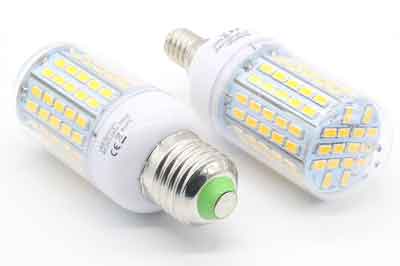If you are looking for LED lamps on international Chinese sellers from AliExpress, Ebay, or similar, you will find a variety of very cheap LED lamps that integrate the SMD 5730 LED.
This family of LED lamps is made up of a cluster with a variable number of SMD 5730 LEDs. The dimensions and characteristics of the lamp depend on the number of LEDs installed. The prices range from €1.20 to €1.70 depending on power.
We find models with E27 or E14 bases. Although this does not affect the technical characteristics of the lamp, logically we will have to buy the appropriate lamp for our luminaire.
However, the technical specifications given by Chinese sellers are quite unreliable (to put it mildly). So, many doubts arise regarding these lamps.
Are these lamps really efficient? Are we wasting money? Is it better to buy an LED lamp from a known manufacturer? It may even be worth asking, are compact fluorescent lamps better? Is it worth replacing them?
With so many questions, I felt like conducting an experiment to really check if these very cheap lamps are worth it, or if their characteristics and efficiency are so bad that it is not worth buying them.
So in this post, we are going to compare different models of Chinese LED SMD 5730 lamps against different types of incandescent and compact fluorescent lamps (CFL).
LED SMD 5730
First, let’s look at the technical characteristics of the SMD 5730, extracted from its DataSheet.
| Dimensions | 5.7 x 3.0 x 1.0 mm |
|---|---|
| Operating Voltage | 3.1-4V |
| Maximum Current | 150mA |
| Luminous Flux | 35-55 lm |
| Power | 0.53W |
| Angle | 120º |
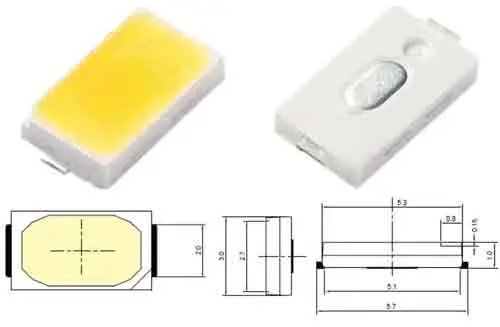
Test Parameters
Although this test is completely homemade, to make it at least useful, we will try to give it a certain rigor, within the technical means available to me. Therefore, first, we will present the test parameters.
Lamps Tested
For the test, we have several models of LED SMD 5730 lamps that I bought for the test, with different numbers of LEDs and all of them in white color.
To compare, we have different types of incandescent and compact fluorescent lamps. Basically, everything I could find at home, and that was not very old to avoid degradation in performance.
Logically, we already know that incandescent lamps are going to give very poor results. But they serve as a reference for comparison or “control pattern”. After all, lamp manufacturers always compare efficiency with the equivalent in incandescent, not between each other.
Much more interesting is the comparison with compact fluorescent lamps. In theory, the results of luminous efficiency should be in the same order of magnitude as an LED lamp. Compared to a quality LED lamp, it is predictable that the CFL will lose, but what about these cheap SMD 5730 LED lamps?
The lamps we are going to test are, from top to bottom, and left to right.
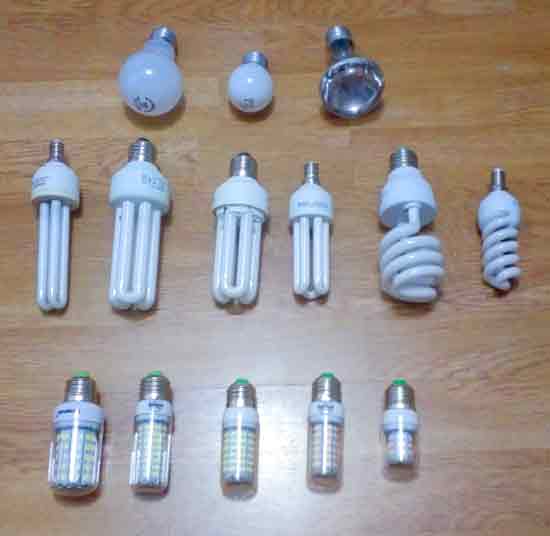
Incandescence
- Spherical 60W incandescent lamp
- Spherical 40W incandescent lamp
- Spot 60W incandescent lamp
Compact Fluorescent
- Double tube 15W CFL lamp
- Triple Tube 21W CFL lamp
- Triple Tube 20W CFL lamp
- Triple Tube 11W CFL lamp
- Spiral 22W CFL lamp
- Spiral 20W CFL lamp
LED SMD 5730 Lamp
- 108 SMD LED lamp (11W?)
- 80 SMD LED lamp (9W?)
- 69 SMD LED lamp (7W?)
- 48 SMD LED lamp (5W?)
- 24 SMD LED lamp (3W?)
The nominal power data for incandescent and compact fluorescent lamps are printed on the lamps themselves, so there is no doubt about the manufacturer’s specifications.
However, Chinese LED SMD 5730 lamps have no power reference on the lamp itself or on the box. The only reference we have is on the sellers’ pages, and we see many discrepancies.
The powers listed above (hence they appear between ?) are the most “reasonable” from the various ads we have seen. But we also find that other sellers put much higher powers for the same lamps (see next image). We will discuss this further.
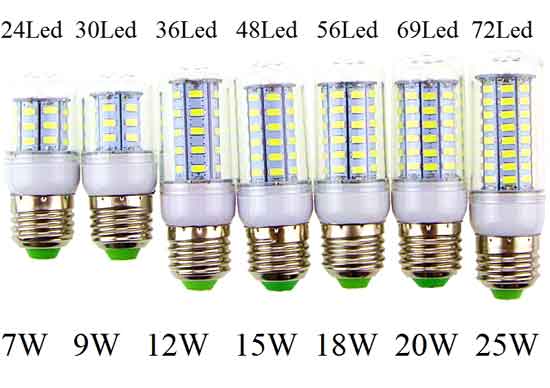
On the other hand, it must be said that the 24SMD, 48SMD, and 69SMD lamps are from one seller, and the 80SMD and 108SMD lamps are from another. Externally, they seem to be from the same range, but I cannot guarantee that they are identical internally.
Electric Measurement
For the electrical measurement, I will use a KETOTEK electrical power meter, a device that is normally installed on a DIN rail and allows measuring electrical current, voltage, real and apparent power, and the power factor.
For the measurement, I have attached two E14 and E27 sockets, because I have lamps with both types of sockets. The socket should be completely independent of the lamp’s behavior.
The setup is as follows.
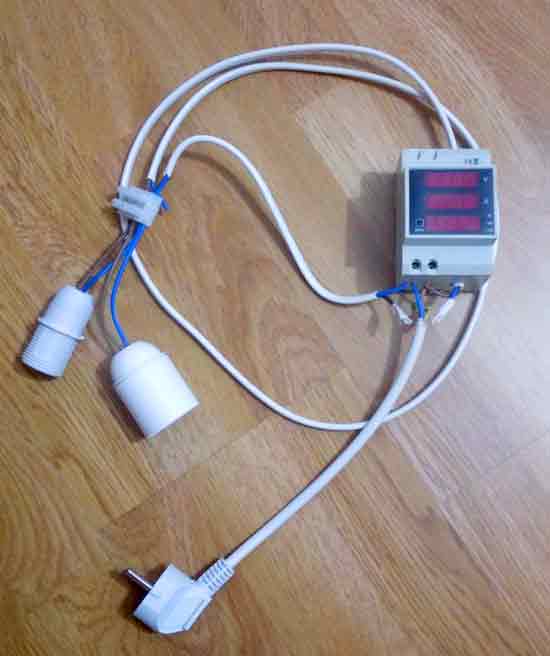
On the other hand, I am going to use a non-invasive current sensor SCT-013 connected to an Arduino. The reason is that I want to have a second measurement of power consumption, since the current meter is not intended for such small loads. And, on the other hand, I want to take the opportunity to check the accuracy of the SCT-013.
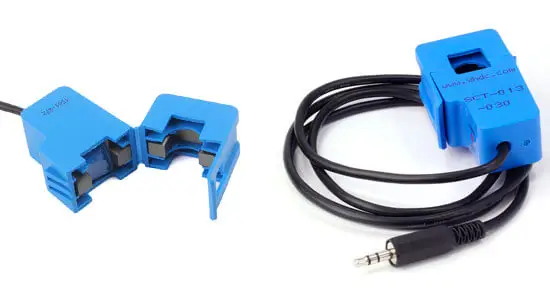
Luminous Measurement
For the characterization of the lamps, we should measure the lumens emitted by the lamp. Unfortunately, I do not have an integrating sphere in my living room, so we will have to settle for measuring lux.
Therefore, the lighting measurements will not be absolute, but quantitative. In other words, they will serve to compare the lamps with each other, but the numerical value itself does not have a physical meaning beyond this test.
For the measurement, I have placed two chairs with a crossbar on them. In the middle of the wooden crossbar, I have a hook, which I will use to place the lamps in the same place every time. The distance from the lower end of the base to the ground is 700mm.
During the lamp changes, we will keep the position of the socket fixed. Since the lamps have different lengths, the lamp’s light center will vary relative to the sensor.
Keeping the socket, rather than the center of the lamp, is done because, in reality, when changing a lamp, what we keep still is the socket or the luminaire. However, in reality, the distance is usually also greater than 700mm, so the effect of the lamp’s length may have less influence than in this test.
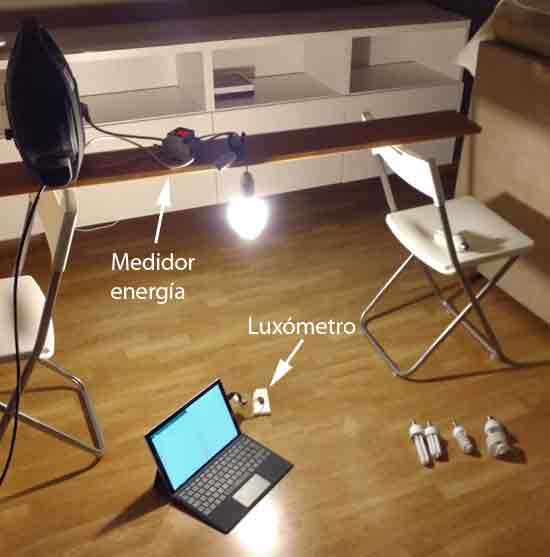
The test was done at night and in the absence of any other source of light. On the other hand, the lamps are far from walls and ceiling, so that the light reflections from the environment have minimal influence, and the lux measurements characterize the lamp as best as possible, and not the room.
As a lux meter, I will use a BH1750 connected to an Arduino and a computer.
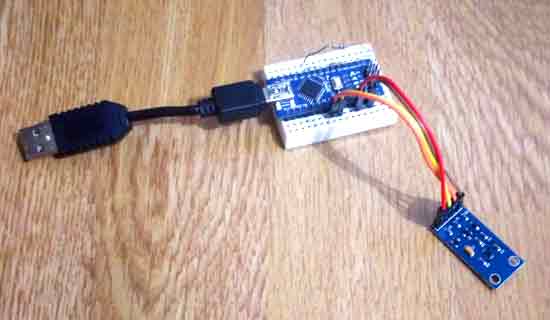
On the other hand, since the lamps have different distributions depending on the angle, I will take the measurement at 0º (facing the lamp) and at 90º (transverse to the lamp).
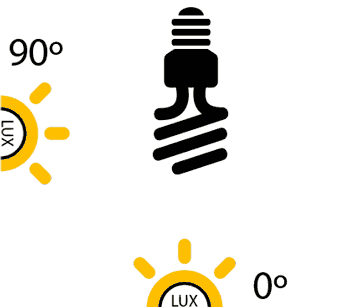
To avoid moving the lux meter and changing its position, we will first take all measurements at 0º and then at 90º. This way we can keep the sensor fixed during each series of measurements.
In the 0º location, the sensor is simply placed on the floor
In the 90º location, the sensor is attached to one of the chairs.
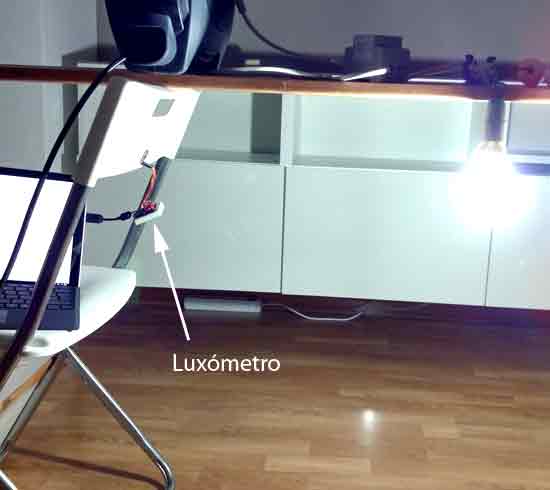
In both orientations, I have tried to keep the distance to the lux meter at 700mm. However, given the change in conditions (sensor location and its environment), it will not be entirely correct to compare the lux values at 0º and 90º. However, I repeat that I have tried to be as precise as possible so that they are comparable.
Each setup is recorded for 10 minutes and the final value of the measurement is the average of the last 20 seconds of the measurement. This has been done because fluorescent lamps increase their brightness over time, until they reach a stable value. On the other hand, LED lamps slightly decrease their brightness over time, due to the increase in temperature.
However, it is possible that after 10 minutes, the CFL lamps could increase their value even more. In any case, at 10 minutes the observed value remained stable. Although it is possible that in continuous operation for several hours, CFL lamps could increase their brightness even more, I consider that,
- The remaining increase should be quite small.
- The possible “penalty” does not seem too unfair, since we often turn on the light for less than 10 minutes. If it takes you 2 hours to reach the nominal illumination, you “deserve” to be penalized a little.
- I cannot test eight lamps for several hours, at two different angles, because… I need to use my living room and I have a life and stuff.
Results
Incandescent Lamps
As we have said, incandescent lamps are going to be our “control pattern”. We already know that incandescent lamps are inefficient and should not be used, but they will serve to compare with the rest.
Here are the electrical measurements,
| Lamp | Nominal | VA | W | CosPhi | SCT013 |
|---|---|---|---|---|---|
| Spherical | 40W | 36 | 36 | 1.00 | 36 |
| Spherical | 60W | 56 | 56 | 1.00 | 54 |
| Spot | 60W | 54 | 54 | 1.00 | 52.8 |
We see that the power factor is 1. Therefore, the apparent power (VA) and the active power (W) coincide. On the other hand, the measured values are quite close to the nominal powers marked by the manufacturer.
Finally, the measurement with the STC-013 also closely approximates what was recorded by the power meter.
Regarding lighting, here are the values,
| Lamp | Nominal | Luxes 0º | Luxes 90º |
|---|---|---|---|
| Spherical | 40W | 92.00 | 122.00 |
| Spherical | 60W | 147.00 | 206.00 |
| Spot | 60W | 1200.00 | 43.00 |
In the spherical lamps, the luxes at 0º and 90º are of the same order of magnitude, while in the spot lamp, logically, most of the light is directed towards the front.
As for efficiency, we get the following.
| Lamp | Nominal | Lux0º/W | Lux90º/W |
|---|---|---|---|
| Spherical | 40W | 2.56 | 3.39 |
| Spherical | 60W | 2.63 | 3.68 |
| Spot | 60W | 22.22 | 0.80 |
These values will be taken as reference for comparison with the CFL and LED SMD 5730 lamps.
But I must reiterate that the Lux/W measurements are quantitative, valid for comparison in this test. But outside of the test (or if we modify any element of the setup), the number no longer has a physical meaning.
Beyond the measurements, the lamps heat up to the point of burning to the touch within a few seconds of being connected. A total waste of energy!
Compact Fluorescent Lamps
Next, we have the electrical measurements for the compact fluorescent lamps.
| Lamp | Nominal | VA | W | CosPhi | SCT013 |
|---|---|---|---|---|---|
| 3 tubes | 21W | 29 | 14 | 0.52 | 16.4 |
| 3 tubes | 20W | 23 | 11 | 0.50 | 13 |
| 3 tubes | 11W | 15 | 6 | 0.40 | 8.2 |
| 2 tubes | 15W | 23 | 11 | 0.48 | 13.7 |
| Spiral | 20W | 15 | 7 | 0.47 | 9.8 |
| Spiral | 22W | 22 | 11 | 0.50 | 12.5 |
It is quite interesting. First, and curiously, the lamps do not comply with the nominal power specifications of the manufacturer by any chance, despite being lamps from recognized brands (these are not Chinese!). I expected more rigor in terms of the nominal value.
On the other hand, and as expected, we have a very low power factor, around 0.5. This makes the active power (W) absorbed around half the apparent power (VA)
On the other hand, the SCT-013 seems to have deviations from the active power. The measurement I obtained is slightly higher. At first, I would say that the power factor is causing the deviation. I note this as a point to consider in subsequent calibrations of the SCT-013.
As for the lighting, these are the recorded values,
| Lamp | Nominal | Luxes 0º | Luxes 90º |
|---|---|---|---|
| 3 tubes | 21W | 140 | 394 |
| 3 tubes | 20W | 135 | 323 |
| 3 tubes | 11W | 70 | 198 |
| 2 tubes | 15W | 59 | 215 |
| Spiral | 20W | 82 | 147 |
| Spiral | 22W | 143 | 157 |
Which in terms of efficiency becomes the following,
| Lamp | Nominal | Lux0º/VA | Lux90º/VA | %(VA)/incan |
|---|---|---|---|---|
| 3 tubes | 21W | 4.83 | 13.59 | 388% |
| 3 tubes | 20W | 5.87 | 14.04 | 401% |
| 3 tubes | 11W | 4.67 | 13.20 | 377% |
| 2 tubes | 15W | 2.57 | 9.35 | 267% |
| Spiral | 20W | 5.47 | 9.80 | 280% |
| Spiral | 22W | 6.50 | 7.14 | 204% |
And now comes a very interesting part. Regarding the apparent power, compact fluorescent lamps are between 2-4 times more efficient than incandescent lamps.
However, most domestic users (unlike industrial consumers) pay for active power (W) and not for apparent power (VA), as long as we do not exceed a power factor of 0.9, at which point we start being charged a surcharge for reactive power consumption.
With respect to active power, the efficiency is 4-9 times that of an incandescent lamp.
| Lamp | Nominal | Lux0º/W | Lux90º/W | %(W)/incan. |
|---|---|---|---|---|
| 3 tubes | 21W | 10.00 | 28.14 | 804% |
| 3 tubes | 20W | 12.27 | 29.36 | 839% |
| 3 tubes | 11W | 11.67 | 33.00 | 943% |
| 2 tubes | 15W | 5.36 | 19.55 | 558% |
| Spiral | 20W | 11.71 | 21.00 | 600% |
| Spiral | 22W | 13.00 | 14.27 | 408% |
In other words, the fact that the lamp is consuming reactive power, for practical purposes for us, is “improving” the efficiency of the lamp, because a domestic consumer does not pay for VA but for W.
With this, we are not saying that consuming a little reactive power is good. In fact, we should have the installation compensated for reasons of “electrical hygiene”.
But the truth is that, in this case, it is cheaper for us because the power in W is half that of VA. (as long as we do not reach the penalty of 0.9, which should not happen if the only uncompensated inductive loads we have are a reasonable amount of compact fluorescent lamps).
LED SMD 5730 Lamps
Finally, we come to the SMD5730 lamps. These are the electrical measurements,
| Lamp | Nominal | W | VA | CosPhi | SCT013 |
|---|---|---|---|---|---|
| 24 smd | 3W | 6 | 6 | 0.00 | 7 |
| 48 smd | 5W | 4 | 4 | 0.00 | 5.18 |
| 69 smd | 7W | 4 | 4 | 0.25 | 4.65 |
